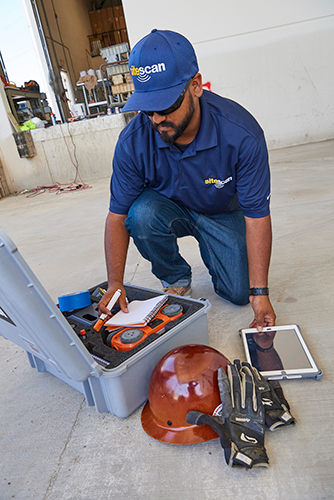In-Depth Insights right into Concrete Scanning Procedures
In-Depth Insights right into Concrete Scanning Procedures
Blog Article
Unveil the Transformative Power of Concrete Scanning in Optimizing Efficiency and Safety
Concrete scanning has emerged as a vital device in the building market, using exceptional advantages in improving job efficiency and making certain security standards. By using sophisticated technology, concrete scanning allows professionals to see beyond the surface area, uncovering covert intricacies that could impact the architectural honesty of a building. The transformative power of concrete scanning lies in its capacity to provide real-time data and detailed understandings, reinventing just how projects are prepared and implemented. As we explore the ins and outs of this cutting-edge technique, a world of opportunities opens up, showcasing a new era of building practices that focus on precision and safety.
Significance of Concrete Scanning
Making certain the structural integrity and security of construction tasks begins with the critical step of conducting comprehensive concrete scanning. Concrete scanning is a non-destructive approach used to identify and map subsurface elements within concrete frameworks.
In addition, concrete scanning aids in optimizing job timelines and spending plan by preventing unforeseen costs and delays that may occur due to unanticipated blockages within the concrete. Inevitably, spending in detailed concrete scanning is a proactive technique that improves both effectiveness and safety in construction tasks.
Just How Concrete Scanning Functions
Concrete scanning runs as a crucial tool in building jobs by using innovative modern technologies to find and map subsurface aspects without triggering structural damage. Ground Penetrating Radar (GPR) and Electromagnetic Induction (EMI) are two main techniques made use of in concrete scanning. GPR jobs by giving off high-frequency radar pulses into the surface, which recuperate when they encounter subsurface things or spaces. The time considered the signal to return indicates the depth and location of the items. EMI, on the other hand, uses electro-magnetic areas to determine variations in material structures, such as determining rebar or avenues within concrete frameworks.
During the scanning procedure, the data gathered is assessed in real-time, enabling prompt recognition of potential dangers or barriers below the surface area. This details aids in decision-making, making certain that construction tasks proceed safely and successfully. Furthermore, 3D imaging software program can be utilized to develop in-depth maps of the subsurface elements, additionally improving project planning and implementation. By utilizing these innovative technologies, concrete scanning significantly decreases the danger of pricey problems and injuries on construction sites.
Advantages of Concrete Scanning
Utilizing innovative scanning technologies in building jobs provides a wide range of advantages, enhancing both performance and security on-site. One of the main benefits of concrete scanning is the capability to discover and locate embedded objects such as rebar, post-tension wires, and channels accurately. By identifying these components prior to boring or cutting right into concrete frameworks, the danger of unexpected strikes is dramatically lowered, stopping prospective injuries to workers and damage to the framework itself. Concrete scanning aids in preparation and creating much more effectively, as it supplies accurate details regarding the location and deepness of architectural components.

Situation Studies: Concrete Scanning Success

In another case, a construction company utilized 3D concrete scanning to examine the condition of aging concrete frameworks in a historical building. The in-depth scans offered beneficial understandings right into the degree of damage and helped prioritize upkeep initiatives successfully. By proactively dealing with areas of worry recognized through scanning, the business had the ability to prolong the lifespan recommended you read of the framework and make sure owner safety and security.
These study emphasize the transformative power of concrete scanning in improving effectiveness, precision, and safety and security in building and construction jobs.
Carrying Out Concrete Scanning in Projects
Applying sophisticated scanning modern technologies throughout construction tasks has come to be significantly necessary for enhancing accuracy and safety. By integrating concrete scanning right into task planning and execution, building and construction teams can identify possible hazards, such as rebar or post-tension cords, concealed within concrete structures. This positive technique lessens the threat of crashes, hold-ups, and pricey rework, inevitably leading to more reliable project timelines and spending plans.
To execute concrete linked here scanning effectively, project managers must collaborate very closely with experienced scanning specialists to establish one of the most suitable scanning techniques for the specific job needs. Engaging scanning experts from the very early phases of a task allows the group to produce thorough scanning strategies that attend to key locations of issue and ensure complete information collection.
Furthermore, including concrete scanning right into regular task operations can improve decision-making procedures, as real-time check data offers instant understandings into the problem of concrete frameworks - Concrete Scanning. This data-driven technique assists in informed analytical and enables teams to make modifications quickly, fostering a culture of effectiveness and security throughout the project lifecycle

Conclusion
In final thought, concrete scanning plays an essential function in boosting efficiency and safety and security in building and construction projects. By using sophisticated innovation to detect and map out underlying structures within concrete, this procedure aids to stop expensive blunders, make sure structural honesty, and decrease threats on website. With the capacity to reveal surprise components and supply exact data, concrete scanning shows to be a beneficial device for optimizing task end results and making the most of total success.
Concrete scanning is a non-destructive method utilized to find and map subsurface components within concrete frameworks. In addition, concrete scanning helps in maximizing project timelines and budget by avoiding unanticipated expenses and delays that may arise due to unanticipated blockages within the concrete. One remarkable situation study includes a large renovation job where concrete scanning played a critical duty in guaranteeing task success.In one more case, a building company utilized 3D concrete scanning to assess the condition of aging concrete frameworks in a historic building. By incorporating concrete scanning into task planning and implementation, construction groups can determine possible risks, such as rebar or post-tension cords, concealed within concrete frameworks.
Report this page